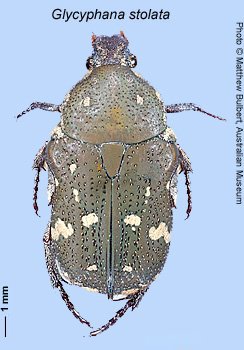
Glycyphana stolata (F.)

|
Diagnostic description |
|
|
Length |
8-11 mm |
|
Colour |
Dorsum various shades of green or brown, with red or dark red clypeus, legs and pygidium, and spots and flecks of white or creamy-white dense microtrichiae; pattern of microtrichial patches variable, but at least as follows: pronotal lateral margins (at least partly), several spots on elytron, which may be joined, most of pygidium; mesoventrite process brown, green or red; setae pale, thick and slightly curled; upper surface dull. |
|
Head |
Clypeal margin shallowly notched, internal angle 120-145 degrees; densely and strongly punctured and entirely setose (often worn off clypeus); antennal club as long as or slightly shorter than remaining segments. |
|
Pronotum |
Lateral margins almost parallel in basal half; strongly but sparsely punctured, with short pale setae; most punctures C-shaped; basal margin shallowly emarginate at junction with scutellum. |
|
Scutellum |
Elongate-triangular, with blunt rounded apex; glabrous and impunctate or with scattered setose C-shaped punctures. |
|
Elytra |
Almost evenly covered with large, mostly C-shaped punctures, generally seriate on disc and often forming linear grooves near suture; short curved setae present throughout, or often absent from disc; scutellar groove absent; apical half of suture strongly raised, with a sharp keel, terminating as sharp prominent lobes; humeri prominent, and elytral margins sinuate, strongly contracted behind humeri. |
|
Mesoventrite process |
Not developed, a small transverse plate with truncate anterior margin, separated from the intercoxal process of the metaventrite by a deep transverse groove and row of erect setae. |
|
Abdomen |
All ventrites with scattered short scale-like setae and punctures in both sexes; punctures U-shaped. |
|
Legs |
Fore tibia with two long and curved teeth on external edge; claws symmetrical; posterolateral corner of hind coxa not produced, evenly rounded; hind femur straight, without lobe on ventral edge; hind tibia slightly thinner than femur, straight, expanded at apex, with small median tooth and internal fringe of long setae; hind tibial spurs thin and sharp in both sexes. |
Distribution and biology: Glycyphanus stolata is a common species on the Dividing Range and coastal plain of eastern Australia, from central NSW, to north QLD. The old record from Sydney has been queried (Bacchus 1974) but the Australian Museum has recent material from Ourimbah, just north of Sydney. There are old doubtful records for TAS (Bacchus 1974) and a single record for western SA (Matthews 1984).
Adults are active from September to May and have been collected on flowers of a wide variety of plants: Angophora, Eucalyptus, Helichrysum, Leptospermum, Melaleuca, Pittosporum, Terminalia, Viburnum. Adults have also been collected on sugar-cane (Australian Museum specimens). The life-history is unknown.
Notes: There is no obvious sexual dimorphism in this species. Before the genus Glycyphanus was revised in 1974 (Bacchus 1974) the species were confused and often misidentified, therefore early published records are unreliable.
References: Bacchus 1974, Matthews 1984, Hawkeswood 1991; Cassis & Weir 1992, Allard 1995.
